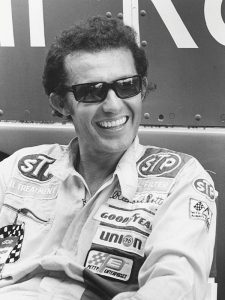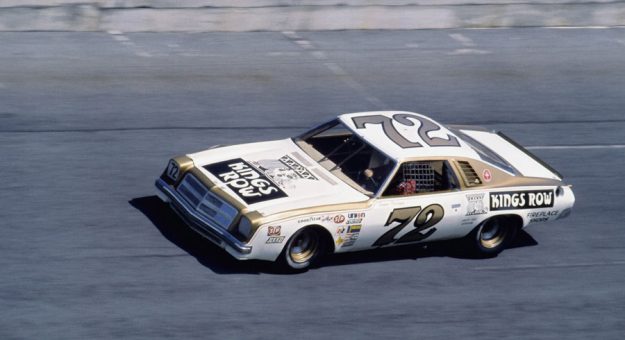Editor’s Note: NASCAR is celebrating its 75th anniversary in 2023. SPEED SPORT was founded in 1934 and was already on its way to becoming America’s Motorsports Authority when NASCAR was formed. As a result, we will bring you Part 28 of a 75-part series on the history of NASCAR as told in the pages of National Speed Sport News and SPEED SPORT Magazine.
Since its inception in 1948, critics had called NASCAR a “Southern” or “rural” sport with little appeal to the majority of Americans who resided in the rest of the country.
This opinion persisted despite successful annual races near Los Angeles, Detroit and Philadelphia.
NASCAR also boasted greater attendance figures than any other professional sport and a multinational corporation as title sponsor of its most prestigious division. However, the skeptics ran out of gas as NASCAR started the 1975 Winston Cup season.
The Jan. 8 Issue of National Speed Sport News reported NASCAR’s 3-year pact with CBS to televise the World 600 at Charlotte Motor Speedway and the Winston 500 at Talladega Superspeedway, plus two or three races to be announced. CBS joined ABC, which began televising Winston Cup races in 1970, to bring the number of televised Winston Cup events to 10 in 1975.
NASCAR President Bill France Jr. was elated: “Not only is televising NASCAR races a boon for the sport itself, but will be highly attractive to sponsors and potential sponsors of racing teams at a time when exposure for them is most needed.”
Rising Cost Of Operation For NASCAR Teams
Sponsors were needed to offset the rising cost of fielding a Winston Cup team.
A newly instituted Awards and Achievement plan guaranteed appearance fees of $3,000 for each superspeedway race and $2,000 for each short track event to Richard Petty, Cale Yarborough, Buddy Baker and K&K Insurance pilot Dave Marcis, plus fees of $500 and $250 to top-20 teams, but the money was not enough to convince sponsorless team owners Junior Johnson (Yarborough) and Bud Moore (Baker) to agree to attend all 30 Winston Cup events.
Johnson and Moore started the year, as did 1973 champion Benny Parsons, without significant outside financial support.
The Carling Brewing Company quit its six-month involvement in NASCAR because increased shipping costs offset the increase in sales generated by its support of Johnson’s car.
Also, Royal Crown Cola quit supporting Moore’s team after 1974. Parsons lost his car and his sponsor when the L.G. DeWitt Trucking Com. dropped its racing program because its prime sponsor, Kings Row Fireplace Shops, failed to fulfill its financial obligations. This left three of NASCAR’s most recognizable drivers — Yarborough, Baker and Parsons — in jeopardy of missing much of the season.
110,000 Fans Witness Daytona 500 In-Person
NASCAR enthusiasts returned to Daytona Beach, Fla. For the Daytona 500, the second half of which was televised live by ABC. Viewers across the nation watched as Yarborough, Petty, Baker and David Pearson dueled for the point.
After a lap-173 restart, Pearson roared away from the field.
Yet, the skilled driver of the No. 21 Purolator Mercury spun on to the infield grass with three laps to go. By the time he recovered, Parsons, who had drafted with Petty and A.J. Foyt to stay on the lead lap after starting 32nd, was on track for his only Daytona Int’l Speedway victory.
Daytona Int’l Speedway hosted the largest crowd to date to witness a sporting event in the southern U.S. as 110,000 fans watched the event in person. More significantly to NASCAR and its detractors, the Daytona 500 on ABC outdrew a National Basketball Ass’n game on CBS and a National Hockey League game on NBC.
Petty Dominates
Petty, the five-time champion finished seventh to start the season at Riverside Int’l Raceway and in the Daytona 500, but the results were dramatically different at Richmond, Va.
The 37-year-old Petty started on the pole and headed 440 of the 500 laps and finished six laps ahead of his nearest competitor for his 165th Cup Series victory and 13th at Richmond Fairgrounds Speedway.
Cold and snow couldn’t stop Petty at Bristol (Tenn.) Motor Speedway on March 16 as he started outside the front row and won by six laps while averaging a record 97.053 mph for the 500-lap run on the .533-mile track.

Later in the season, the Petty Enterprises 1974 Dodge Charger graced victory lane at North Wilkesboro (N.C.) Speedway for the 12th and 13th times in Petty’s 18-year career. He also won at Martinsville (Va.) Speedway for the 14th time.
Yet, Petty, who had always excelled on short tracks, but sometimes struggled on superspeedways, dominated the long circuits as well in 1975. Part of the reason can be attributed to the financial crisis at Chrysler Corp., which forced the car maker to cut production of the Charger.
So instead of a 1975 model, Maurice Petty chose to use the aerodynamic year-old Charger design.
The strategy paid dividends on the long tracks which now dominated the Cup Series schedule. Petty won the Atlanta 500 in March and rallied from two laps down to capture the World 600 at Charlotte Motor Speedway on May 25.
The CMS victory was his first in 28 starts at the 1.5-mile superspeedway, but not his last, as he won again there in October.
The Winston Cup tour made two visits to Michigan lnt’l Speedway and Petty finished a close second to Pearson June, but won the August event. Daytona’s Firecracker 400 also belonged to the No. 43 car.
Petty patiently watched as Pearson drafted with Buddy Baker for the first 140 laps of the 160o-lapper. Then, on lap 141, Pearson’s engine blew and Baker took over the lead with Petty on his bumper. On the 148th tum, Baker fell behind the lapped car of Richard Brooks and Petty grabbed the victory.
Tragedy struck during the rain-delayed Aug. 20 event at Talladega (Ala.) Superspeedway. Forty-three-year-old Dewayne “Tiny” Lund died in a six-car pileup on the eighth lap.
The popular Cross, S.C., dirt-track legend died of massive chest injuries.
Other Drivers Taste Victory, But Petty Steals The Crown
Lund dominated two of NASCAR’s divisions in the late 1960s and early 1970s, winning three Grand American and one Grand National East title. In 1975, another dirt-track pro, Ray Elder, won the Grand National West championship.
The Late Model Sportsman crown went to Harmon Dragon, while Jerry Cook won the modified title for a record fourth time.
Meanwhile, the reigning Winston Cup champ’s sixth superspeedway victory of the season came on a crisp September day at Dover Downs lnt’l Raceway. For the first 348 miles, the only question was how many laps the point leader would put on the field.
But on the next lap, a broken flywheel from Lennie Pond’s spent engine broke a tie rod on the STP car, sending the leader to the pits. Petty emerged from pit row eight laps behind race leaders Yarborough and Brooks. Amazingly, on the 496th lap, the No. 43 car held the point again.
It is no wonder Petty responded to a Sept. 11 report in the Charlotte Observer of his imminent retirement in this way: “Does this look like I’m ready to retire? The fun’s still there (and) they’ve still got some races I haven’t won.”
At the conclusion of the season, Petty had won 13 more races to bring his career total to 171, and earned his sixth Cup Series title.
